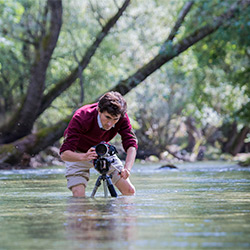 Today’s interview comes from London, in the UK and features the award-winning wildlife Photographer and documentary Filmmaker Paul Alistair Collins. Paul finds inspiration for his work through a close relationship with wildlife and nature. With a unique approach and understanding of lighting, Paul’s work provides the viewer with imagination evoking and dreamlike images of the natural world.
Today’s interview comes from London, in the UK and features the award-winning wildlife Photographer and documentary Filmmaker Paul Alistair Collins. Paul finds inspiration for his work through a close relationship with wildlife and nature. With a unique approach and understanding of lighting, Paul’s work provides the viewer with imagination evoking and dreamlike images of the natural world.
Paul, thank you so much for sharing your experiences with us and thank you so much for all your thoughtful responses. Your work is brilliant and someone who is definitely worth following.
If you would like to see more of Paul’s work, you can visit his website. You can also follow him on Facebook and Instagram.
Can you please tell the readers a bit about yourself?
I’m a professional wildlife photographer and documentary filmmaker based in the UK. I have also worked in theatre and photojournalism, so it has been a fairly varied route leading towards what I do now.
Where do you call home?
I’ve lived in London most of my life but I also have a family home in rural Normandy, France. I feel pretty lucky to have a balance of city and country life, with a rich variety of animals in the local areas. I also studied in Edinburgh and regularly go back there to run photo workshops on the coast, so that feels like another home away from home.
After browsing through your website, I see that you’re truly immersed in the field of photography. What is it that led you towards photography and how long have you been working in it?
I’ve always had an interest in wildlife. Some of my earliest memories feature animals, and making field notes and sketches were my equivalent of keeping a diary. Then during a family holiday to Florida I stumbled upon photography and that clicked for me. My dad, also a keen birdwatcher, had an old film camera. In 2005 our local WWT reserve ran a photo contest, so we started to visit every weekend. There was a resident grey heron which I nicknamed Mr Jones, and I spent about 20 hours with him over 4 days. I don’t think he moved an inch or caught a single fish in that time, but I got one portrait I was quite proud of and it won me the contest. That gave me a confidence boost to pursue photography further.
I’ve also recently learned that my great grandfather was a keen amateur wildlife photographer! So I do think if I hadn’t discovered photography then photography probably would have discovered me eventually.
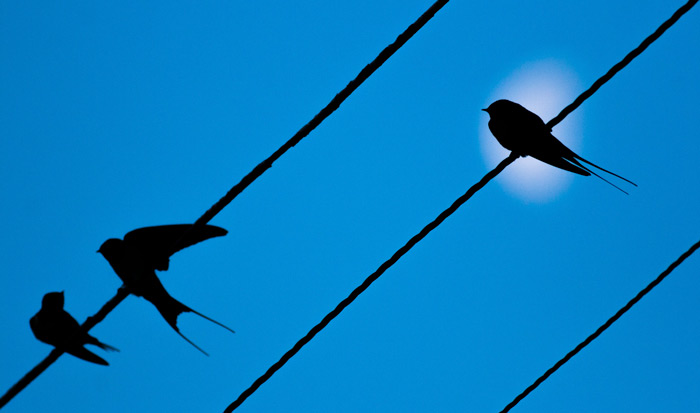
Are you self-taught or formally-taught?
I’m self-taught and I think that the best way to learn is by trial and error, and by just immersing yourself in making photos. I worked as a theatre photographer on the Edinburgh Festival circuit and learned a lot on the job about lighting and what makes good visual stories, which I’ve since tried to apply to wildlife.
Regarding your styles of photography, which do you prefer the most?
It’s an interesting question as I have professional experience in many styles ranging from weddings and theatre to food and photojournalism. Of course wildlife is my favourite subject, but in truth so much of my inspiration for how I use light, colour and composition comes from my theatre and wedding portfolios. Without having worked in those fields, I very much doubt that my wildlife photos would be anything like they are now.

What type of photography shoots do you look forward to?
Anything involving animals. I also relish the challenge of low visibility shoots, such as at dawn, dusk, in snowy or foggy conditions. Light is an incredibly powerful tool which photographers can manipulate to create a sense of wonder and mystery. Fog is particularly great as you are effectively starting with a blank white canvas, and you can build the image up into whatever you want. I’ve had some really magical shoots in the past where animals and landscape details swim in and out of the darkness, and you never really know what kind of images you’ll end up with.

When shooting subjects, what do you find most challenging?
Holding back my excitement a little and maintaining focus. When I’ve been in a hide all day and the animal finally appears, pausing in a ray of the most sublime light, I find it really hard to resist jumping up and down for joy. Being overly excited in the moment can result in missing a shot or being a little reckless.
Also pushing myself that one bit further. Once you find a technique you like, it’s easy to become comfortable and maybe a little complacent, but it’s important to keep things moving and have a bit of variety in your portfolio. For example, I love using shallow focus to suggest a dreamy atmosphere and it has become a bit of a trademark, but it certainly doesn’t work for every image.
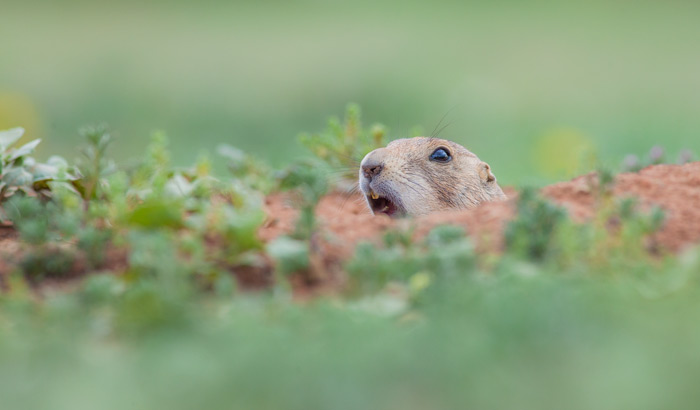

What’s the best part of being a photographer?
Arriving at a location, potentially after months of planning, can feel like meeting a pen-pal in person for the first time. Getting to know the landscape and its animals over time is personally very rewarding, and knowing that no matter how much research you’ve done there will always be surprises.
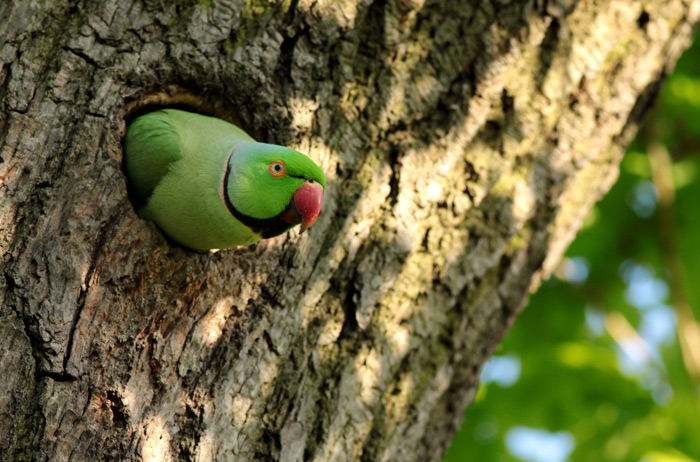
What is the most challenging part of being a photographer?
Balancing the personal enjoyment of photography with the commercial side of it. It’s almost impossible nowadays to work as a wildlife photographer without some other source of income. I work as a TV cameraman, with wildlife photography as a sideline passion which I sometimes monetise through workshops and print sales. I’m fairly active on social media which is good for exposure but it’s quite stressful if you’re always worrying about how many followers you have. Take photos for yourself primarily, and worry about their social/online or commercial appeal later if you have to.
Share with us your favourite image and why.
This photo of a chipmunk from Canada was one of my first serious attempts at wildlife photography and it still remains a favourite. What I like about it is the tenderness of the moment. I’d already taken a few photos of it feeding on the honeysuckle which were okay but a bit too direct and “in your face”, lacking in emotion. By changing my position a little and shooting through the honeysuckle with a wide aperture, the scene was transformed into one of dreamy warmth and soft colours.

How do you keep your photography fresh and how do you stay motivated to keep on learning?
Like many photographers I get moments of creative inertia, especially in the late winter when it’s often too dark and cold to go out for long. Fortunately at this time of year there’s an excellent annual exhibition called Wildlife Photographer Of The Year, showcasing the world’s best current wildlife photography. I look at the work of my favourite photographers such as Vincent Munier, Bence Mate and Sandra Bartocha, and also the work of people I’ve never heard of, and wonder what it is about their photos that makes me say “Wow”. How can I apply that – not copy it, but take inspiration from it – for my own photo projects? It’s impossible to leave that exhibition without feeling inspired.
What also works for me is taking walks without the camera or any technology, just enjoying where I am and “resetting my own batteries”. It’s important to take a brief step back from photography and then re-enter feeling fresh.
What is one piece of advice you would like to offer a new photographer just starting out?
Take the time to find what excites and motivates you. There’s so much focus as a beginner on how to take photos (exposure, camera settings, etc) and not enough on why. What is it about that flower or that landscape that has caught your attention and demands to be photographed there and then?
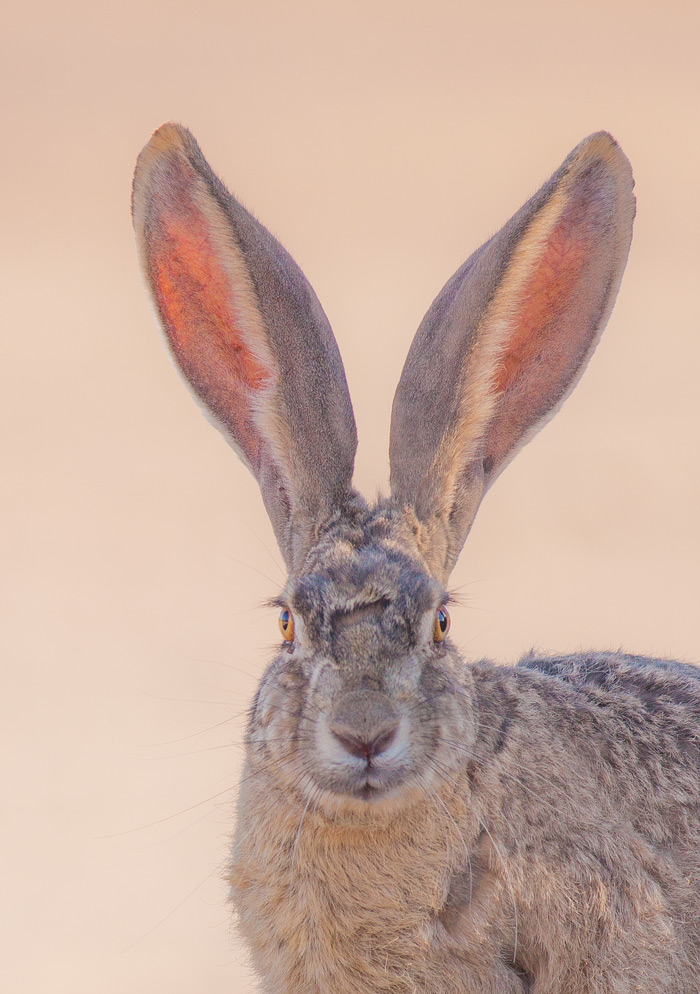
Take this Jackrabbit for example. The first thing you notice are its marvellous long ears. I knew I had to include these in my image (it would have been a crime not to!), so I shot in portrait rather than landscape mode, using them to frame the composition. I also wanted eye contact for a more personal portrait, so I got down low and use a wide aperture to isolate the jackrabbit from its background. The orange sand matches its fur, making an aesthetically pleasing image to look at whilst also giving a sense of place.
When you look more sensitively at your subject and start to explore its character, your passion for it will emerge in your photos and influence the way you take images. This is another area where so many beginners’ photos fall short for me. They don’t take the time to “sketch” – they want to get the photo right first time. Every photographer has a process, and almost every photo you’ve seen that you admire is a result of that process. Is the light right? Is the subject giving its best expression and pose? Do you need to change your perspective? All of the photos that you take and that you might think are terrible aren’t garbage, as they’re the necessary steps to get that better photo and better tell your story. And finally, don’t be upset with so-called “unsuccessful” photos. That only leads to frustration, and if you think of each photo as a “sketch” like I do, it encourages creativity and experimentation and leads to those better photos.
What type of camera(s) do you shoot with? What is your favorite lens?
I shoot with a Canon 5DMkII, switching between a Canon 400mm 5.6 L lens for birds and mammals and a Canon 100mm 2.8 macro lens for smaller creatures and plants. I also have a Canon 500D which I pair with a Sigma 10-20mm f4-5.6 wide angle. I really enjoy using this lens to get very intimate portraits of animals in their environment, such as this Great Bustard in Wiltshire, but it does require getting very close and having an approachable subject to work with. The 400mm has been in my kitbag for the longest and I love how this prime lens can handle tricky low light situations.
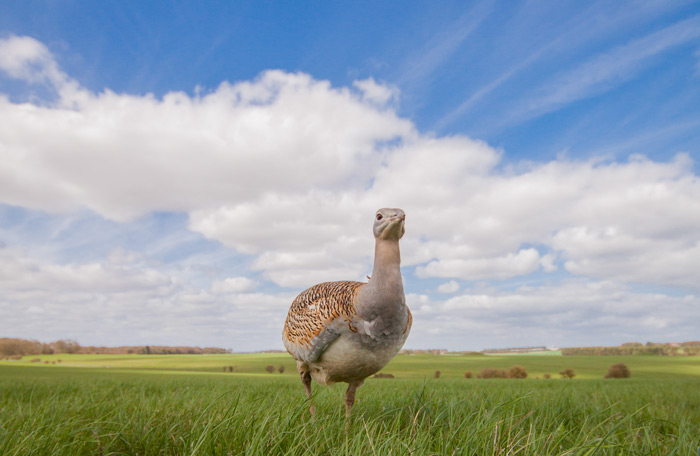
What is in your camera bag?
It depends on where I’m going. If I’m photographing something shy like a wolf, I’ll pack a camouflage hide, heavy-duty tripod and warm clothing. A night photoshoot might involves remote-controlled flashguns and intervalometers. Wherever I go, I always take lots of charged batteries and memory cards, a torch, first aid kit, lens-cleaning kit, energy bars and an extra layer of clothing.
What is your favourite photography accessory?
I genuinely can’t think of one! Probably binoculars, as wildlife watching is more important to me than taking photos, plus they help me to spot animals from a distance and figure out how best to approach.
What piece of equipment would you most like to get but don’t have yet?
I’m pretty happy with my kit and don’t regularly upgrade, but I wouldn’t say no to a Canon 1DX camera or any lens that helps me capture the quality of light more effectively, such as a Canon 500mm 1.4 lens! I’ve toyed with getting underwater housing to photograph the newts and frogs in my garden pond, but I think that’s a long way off happening.
How important is Photoshop or other image editing software in your final images?
Lightroom is essential to my editing process, as often the RAW photo files will need a little extra boost of colour or contrast. Just a few minor adjustments to brightness or a crop, and I always look at the photos a week or two later to see if I’m still happy with the edits. Occasionally images, such as the chipmunk, are not edited at all. I might use Photoshop when the background is a little noisy or dirty, and for checking image quality for advertising workshops, but other than that I steer away from it.

Can you tell me about one of your favourite or most memorable photo shoots? What made it so great and why did you like it so much?
One morning that really sticks out in my mind is during a trip to Dumfries in West Scotland a few summers ago. At twilight, a low mist hung over Carlington Loch. Between 3:30 and 5am, the light magically shifted from indigo blue to honey gold and then to pearly white. At one point a Mute Swan glided along the glassy water, at first a distant silhouette, and then as it came closer I could see the torchlight of its orange bill, a beacon in the mist. Then the trees came into vision, loose inky swirls of branches fraying and drooping. The scene was so simple and harmoniously balanced, just like a Japanese print, as the swan’s curved form passed under the tree.

Do you have any projects that make you look back and shake your head? What made the experience so unpleasant?
I’ve had experiences that were unpleasant in the moment but in the end the good memories always reign. I got caught in a rather nasty sandstorm during a recent camping trip to the White Sands of New Mexico with my friend Mohammad. This didn’t put me off taking photos of the Darkling Beetle which rolls balls of sand up and down the dunes, but I did feel guilty that Mohammad was meanwhile shivering in his tent, sleepless from the wind and getting coated in sand whenever the storm blew through the gauze roof. I hope he wasn’t too traumatised, but in the face of discomfort we both came away with great memories and personal photos of animal life among the dunes.
Are there any areas of photography that you have yet to pick up on that you’d like to learn?
I’d love to try underwater photography one day, although I’m not a confident swimmer so think that could be a set back. It’s the challenge of getting very close to an animal and the way that light moves through the water which appeals.
What do you think the future holds for you? Where do you see yourself in the next few years?
Hopefully I’ll be leading more wildlife and photo workshops in the UK and worldwide. Some of my best recent memories have been giving a friend or stranger their first glimpse of a whale or bear, something which they’ll remember for ever. Photography is about sharing experiences with people, and I’m discovering more and more how much I’d like to give people that access to amazing wildlife too.
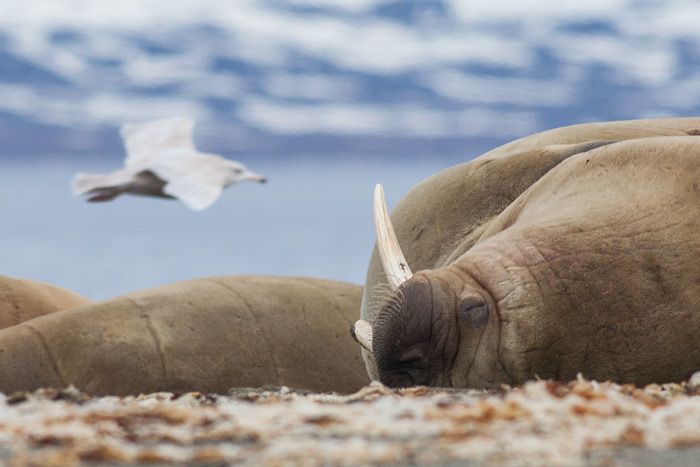
Leave a Reply